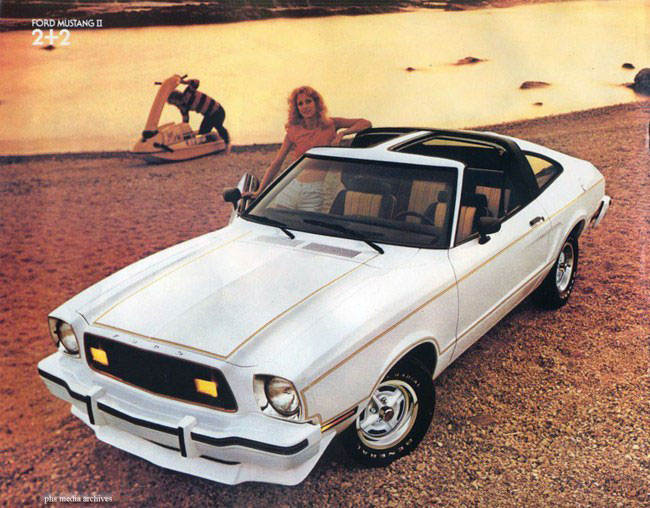Today’s Post by Joe Farace
“There’s less Pinto in a Mustang II than there is Falcon in a 1965 Mustang,”—John Clor, Enthusiast Communications Manager for Ford Performance
While formerly reviled by enthusiasts, Ford’s Mustang II has has finally seen as the model that saved the Mustang. The car was manufactured from 1973 until 1978.According to Pony Parts, for the 1974 model year, Ford sold 385,993 units, which was the fourth most in the iconic vehicle’s five-decade-plus history. The 1974 Mustang more than twice outsold the Chevy Camaro, which had also undergone a major redesign that same year. In an exciting turn of events for Ford, the 1974 Mustang won Motor Trend Magazine’s Car of the Year Award that year.
Mine Mustang II was a 1978 and I was inspired to buy it from the very same ad you see below. Much earlier I owned a 1966 Mustang convertible with 200 cubic inch six-cylinder and Fordomatic transmission and cool wire wheel hubcaps. I was determined that my Mustang II would be different: It had the 302 Windsor V8 and five-speed transmission. It was trimmed out just as you see in the illustration, a white fastback with T-Tops but mine had black pin stripes and interior.
 The Mustang II had no common components with any of its preceding models sharing some of its platform with the equally unloved Ford Pinto but Mustang II’s were used on the original Charlie’s Angels TV show. When I owned it some of my friends called it my Charlie’s Angels’ car even though the car Farah Fawcett drove was a white fastback Cobra with no T-tops.
The Mustang II had no common components with any of its preceding models sharing some of its platform with the equally unloved Ford Pinto but Mustang II’s were used on the original Charlie’s Angels TV show. When I owned it some of my friends called it my Charlie’s Angels’ car even though the car Farah Fawcett drove was a white fastback Cobra with no T-tops.
Lee Iacocca who spearheaded the creation of the Mustang and then presided over turning it into a larger, less nibble car ordered the development of a smaller Mustang for 1974. Initial plans called for a downsized Mustang based on the Ford Maverick that was similar in size and power to the Falcon and it would have been a great way to bringing Mustang back to its roots but that didn’t happen. Instead those plans were scrapped in favor of a smaller Mustang. The final Mustang II production design was set in 1971 by Dick Nesbitt but according to him the new model was “less of a Pinto than the ’64½ had been a Falcon.”
Yet the quality control, at least for my car, was not as good as a Nissan Versa and my car had a number of electrical problems starting with it shutting down at importune times, like while driving down the highway. When it was towed to the dealership, guess what? It started right up. Several months of coping with that porblem got old, I’ll tell ya but finally when it went to the shop and wouldn’t start, they fixed it for not a lot of money.
In 1981 I moved to Colorado and lost all my connections with the Maryland car scene, especially mechanics which ended up costing me dearly. At one point, I had to have a new clutch installed (by an incompetent mechanic) making the car difficult to drive and Mary hated driving it. Ultimately I had transmission problems forced me to sell the Mustang but I still have a sense of nostalgia for the car, more so than my ’66. Every time I see a Mustang II—and they are few and far apart—I get excited. And to tell the truth I really would like to own one again, if I could find another T-Top fastback.
If you enjoyed today’s blog post and would like to treat Joe to a cup of Earl Grey tea ($3.50), click here. And if you do, many thanks.
